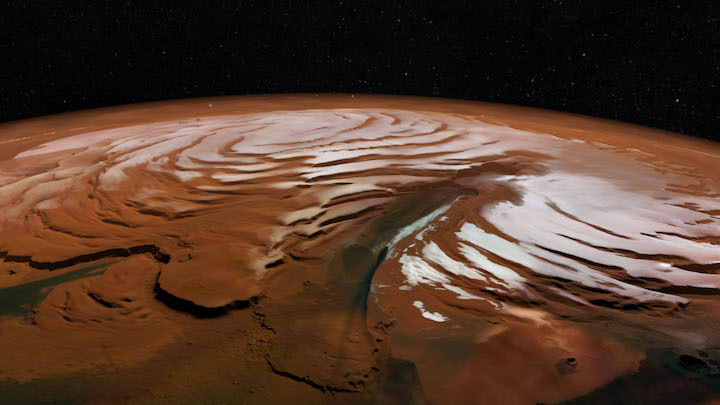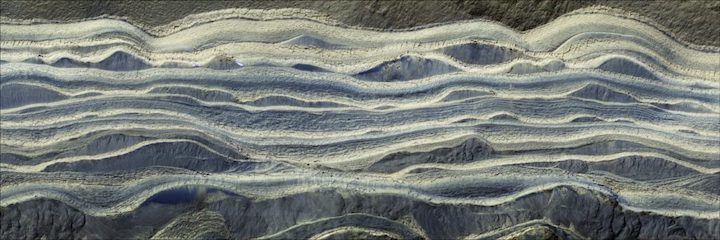24.05,2019

AUSTIN, Texas — Newly discovered layers of ice buried a mile beneath Mars’ north pole are the remnants of ancient polar ice sheets and could be one of the largest water reservoirs on the planet, according to scientists at The University of Texas at Austin and the University of Arizona.
The team made the discovery using measurements gathered by the Shallow Radar (SHARAD) on NASA’s Mars Reconnaissance Orbiter (MRO). SHARAD emits radar waves that can penetrate up to a mile and a half beneath the surface of Mars.
The findings, published May 22 in Geophysical Research Letters, are important because the layers of ice are a record of past climate on Mars in much the same way that tree rings are a record of past climate on Earth. Studying the geometry and composition of these layers could tell scientists whether climate conditions were previously favorable for life, researchers said. The team found layers of sand and ice that were as much as 90% water in some places.
If melted, the newly discovered polar ice would be equivalent to a global layer of water around Mars at least 1.5 meters (5 feet) deep.
“We didn’t expect to find this much water ice here,” said lead author Stefano Nerozzi, a graduate research assistant at the University of Texas Institute for Geophysics (UTIG) who is completing his Ph.D. at the Jackson School of Geosciences. “That likely makes it the third largest water reservoir on Mars after the polar ice caps.”
The findings were corroborated by an independent study using gravity data instead of radar, led by researchers at Johns Hopkins University. Nerozzi was a co-author. The papers have been published simultaneously in Geophysical Research Letters.
The authors think that the layers formed when ice accumulated at the poles during past ice ages on Mars. Each time the planet warmed, a remnant of the ice caps became covered by sand, which protected the ice from solar radiation and prevented it from dissipating into the atmosphere.
Scientists have long known about glacial events on Mars, which are driven by variations in the planet’s orbit and tilt. Over periods of about 50,000 years, Mars leans toward the sun before gradually returning to an upright position, like a wobbling spinning top. When the planet spins upright, the equator faces the sun, allowing the polar ice caps to grow. As the planet tilts, the ice caps retreat, perhaps vanishing entirely.
Until now, scientists thought that the ancient ice caps were lost. The paper shows that in fact significant ice sheet remnants have survived under the planet’s surface, trapped in alternating bands of ice and sand, like layers on a cake.
Co-author Jack Holt, a professor at the Lunar & Planetary Laboratory of the University of Arizona, said that the study provides new, important insights into the exchange of water ice between the poles and the midlatitudes, where his research group previously confirmed the presence of widespread glaciers, also using the SHARAD instrument.

“Surprisingly, the total volume of water locked up in these buried polar deposits is roughly the same as all the water ice known to exist in glaciers and buried ice layers at lower latitudes on Mars, and they are approximately the same age,” he said.
Holt, who was a UTIG scientist and research professor for 19 years before joining the University of Arizona in 2018, has been a co-investigator with SHARAD since the spacecraft arrived at Mars in 2006.
Nerozzi said that studying this record of past polar glaciation could help determine whether Mars was ever habitable.
“Understanding how much water was available globally versus what’s trapped in the poles is important if you’re going to have liquid water on Mars,” Nerozzi said. “You can have all the right conditions for life, but if most of the water is locked up at the poles, then it becomes difficult to have sufficient amounts of liquid water near the equator.”
The study was supported by a grant from the NASA Mars Data Analysis Program and the MRO Project Office at the Jet Propulsion Laboratory. SHARAD was provided to NASA’s MRO mission by the Italian Space Agency.
Quelle: The University of Texas at Austin
